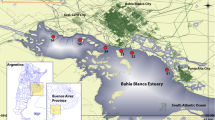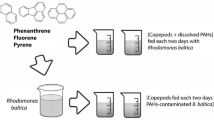Abstract
Bioaccumulation of polycyclic musks (HHCB, AHTN) and nitro musks (musk xylene, musk ketone, and their amino metabolites) in aquatic biota was investigated by analyzing 18 fish samples (rudd, tench, crucian carp, eel) and 1 pooled zebra mussel sample from the pond of a municipal sewage treatment plant. Furthermore, water samples taken at the effluent of the sewage plant as well as water samples and two series of semipermeable membrane devices (SPMDs) from the pond were included. This comprehensive data set allowed the determination of species-dependent bioaccumulation factors on a lipid basis (BAFL), e.g., for HHCB the BAFL in tench were more than 20 times higher than in eel. The BAFL for HHCB and AHTN in biota were lower than the partition coefficients K SPMD/W obtained from SPMD samples, which are assumed to represent model bioconcentration values. This stresses that metabolism of these compounds in fish must not be neglected.
Similar content being viewed by others
Author information
Authors and Affiliations
Additional information
Received: 12 June 2001/Accepted: 1 December 2001
Rights and permissions
About this article
Cite this article
Gatermann, R., Biselli, S., Hühnerfuss, H. et al. Synthetic Musks in the Environment. Part 1: Species-Dependent Bioaccumulation of Polycyclic and Nitro Musk Fragrances in Freshwater Fish and Mussels. Arch. Environ. Contam. Toxicol. 42, 437–446 (2002). https://doi.org/10.1007/s00244-001-0041-2
Issue Date:
DOI: https://doi.org/10.1007/s00244-001-0041-2




